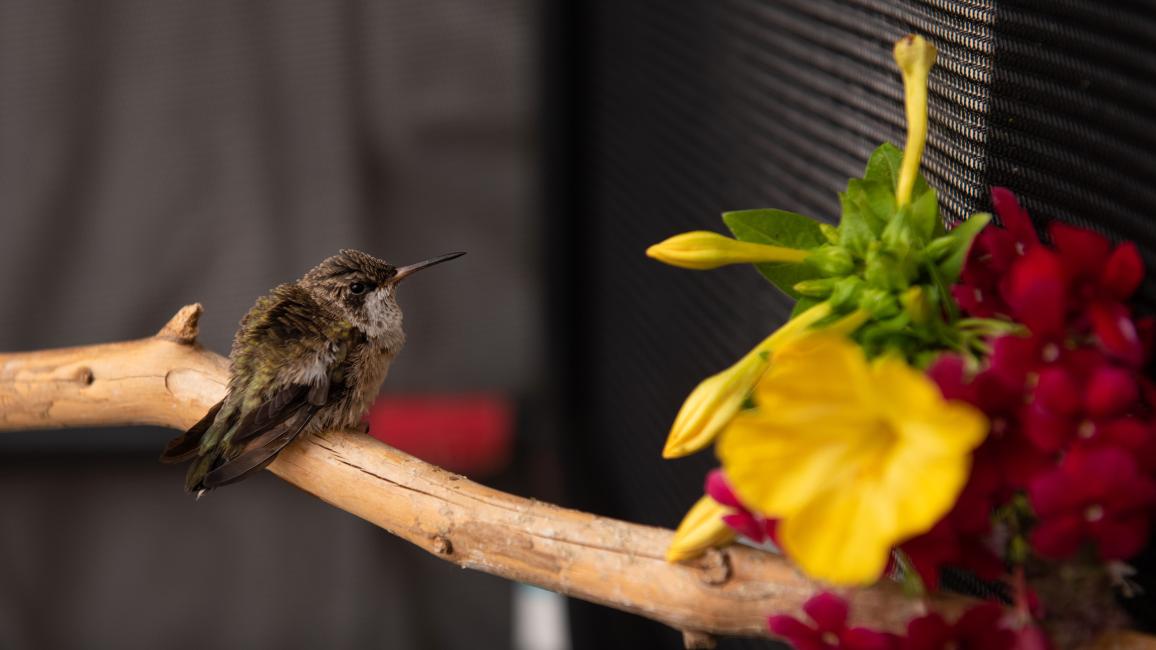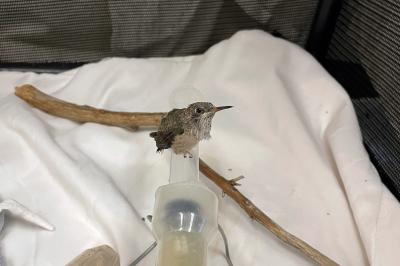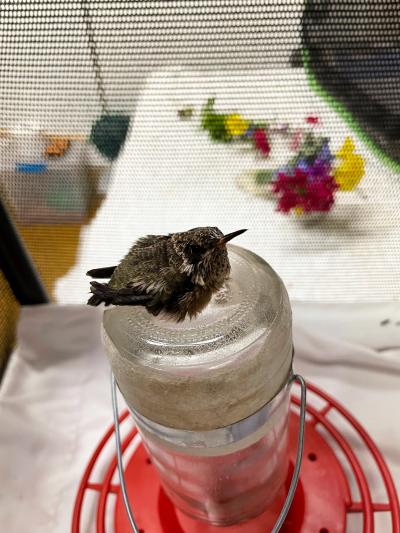Baby hummingbird flies free

The tiny hummingbird didn’t look like much. She was weak, her feathers were ragged and her tiny tongue was hanging out. A kind couple discovered the little bird still in the nest next to her sibling, who, sadly, had not survived. It appeared that something must have happened because the mother hummingbird hadn’t returned to the nest.
The record-setting heat made matters worse because the nest was inside a garage. Things weren’t looking good for the little bird, so the couple called Best Friends for help. The state and federally licensed wildlife rehabilitators on staff at Wild Friends, a special area of Best Friends Animal Sanctuary that cares for local wildlife, were ready to help.
The tiny bird was found in St. George, Utah, about two hours west of the Sanctuary. So, Lauren Ross, licensed sub-permittee, drove to the couple’s house to pick up the bird and bring her to Wild Friends, where she could be well cared for. She brought syringes, containing a high-protein mixture, to feed the young one.
A rocky start
The hummingbird still wasn’t looking well on the way back. Her tongue was still hanging out and she looked tired.
Lauren pulled over to feed her passenger every 15 minutes. The first try was unsuccessful, and the second wasn’t much better. But by the third try, the little bird got the hang of drinking from the syringe. After that, she settled down a bit, her tongue returned to her mouth, and she looked a lot brighter.
[These baby animals were born to be wild]
Lauren had also brought along some pain medication for inflammation, which also seemed to help. By the time they arrived at the Sanctuary, the young one could eat confidently from the syringe all by herself. Rather than being a tiny baby, she was a fledgling, fully feathered and able to fly. But she was still gaping, her open mouth indicating she was hungry.

Getting settled
Caregivers placed the hummingbird into a two-by-four-foot upright enclosure that was four feet high — a good size for her to get lots of exercise. Inside, they put food, flowers and several perches.
They also provided a standard hummingbird feeder with a special high-protein formula. In addition, she had another feeder, a syringe perched on a bent wire that held it up. At first, a bit unsure about the syringe, the little bird sometimes got confused and perched on the top instead of near the front end where she could get to the food. The team kept careful watch just in case she needed any extra assistance finding her food.
Eating like a pro
After three days, during which finding food was kind of hit-and-miss, she became an expert and could reliably find her food every time she looked for it. Getting past the hump of learning to eat reliably on her own erased any remaining challenges, and she was good to go — to live free in the wild.
Caregivers returned her to St. George because the hummingbirds near Best Friends had already started migrating. Hummingbirds stay in St. George year round and even better, their nesting spot is close to where she was found and also near a nature center.
Two weeks after being discovered, the young hummingbird was released. She flew right over to a patch of flowers and some local hummingbirds joined her to say hello. Feeling a little shy, she flew up to a higher tree branch.
Lauren watched for an hour from a short distance away to make sure she was doing OK. She seemed relaxed, happy and lively, and she was soon interacting with the others, enjoying her first day back free in the wild.

Support our wild friends
You can join Best Friends in caring for many species of animals (including wildlife like baby hummingbirds) by becoming a member.
Read more
Barn owls rescued, nest and all, from accidental road trip
Life in captivity? Quoth the ravens, ‘Nevermore’
After falling out of a nest and losing her parents, baby hummingbird was raised by humans